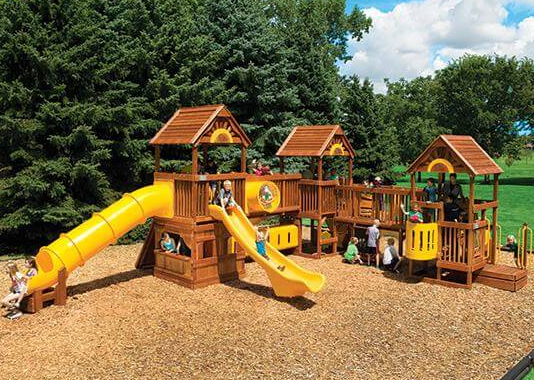It is critical to select commercial playground equipment that suits the age of over 70% of users, for safety and developmental reasons. This knowledge of the differences in needs and capabilities can help recreational administrators, developers or community planners with creating unique yet age specific play opportunities.
Age Appropriate Equipment
Children Playground equipment should accomadate the developmental stages and physical abilities of challenging children. For example, the Consumer Product Safety Commission (CPSC) has age guidelines for toys:
Infant (Age 6-23 months): This age category should provide equipment in terms of sensory play and promote natural exploration, while working on basic motor skills. Low platforms, short slides, crawl spaces and tactile panels are good. Sensory research suggests that up to the age of 1-8, raise a child by Sensory Play will develop their cognitive capabilities upto about 30%.
Toddlers (2 to 5 years old): The play structures for toddlers should allow them climbing, sliding and role-playing. Gear needs to be made smaller so that their size and stuff are scaled accordingly with a safety rail, including steps designed for little feet. Interactive features such as activity panels can also enrich language and social skills.
Incorporating Safety Features
When the equipment of any age level gets to be commercial, regardless from the company that it is bought or exactly where you may have already been made putting in and assembly,it a basic concern for Safety. Equipments must comply with national safety standards to prevent injuries. The essential components include using non-toxic materials, having rounded corners, ground securing options and fall surfacing. Studies demonstrate that playgrounds which have been reconstructed or enhanced with modern safety features are accident rated decrease by 40%.
Designing for Inclusivity
Without consideration for inclusive design, specific aspects of the playground may be inaccessible to certain children with disabilities. Including things like wheelchair-accessible ramps, sensory-friendly activities and adaptive swings to make sure that everybody can have fun at the playground. Providing inclusive designs on playgrounds can increase use by as much a 50% in communities with children who have special needs.

Promoting Education Opportunities
Learning through play is essential for cognitive development. By adding in play-based learning elements like puzzles, counting games and nature exploration activities you can greatly increase the educational opportunity that playgrounds provide. Recent studies established that children who trained with educational playground equipment demonstrated enhanced memory and problem solving.
Long-term durability and maintainenance
When you choose products constructed from high-quality, robust materials, it will last and minimise your maintenance cost. Common options include weather-resistant metals, recycled plastics and wood that's been responsibly harvested. That investment in quality materials can reduce maintenance costs by more than 25% over five years, providing a better overall value for the community.
Communities carefully choosing playground equipment, designed for the developmental needs of children within a wide range of age groups and competencies, ensure safe opportunities for play that are optimal to learning.